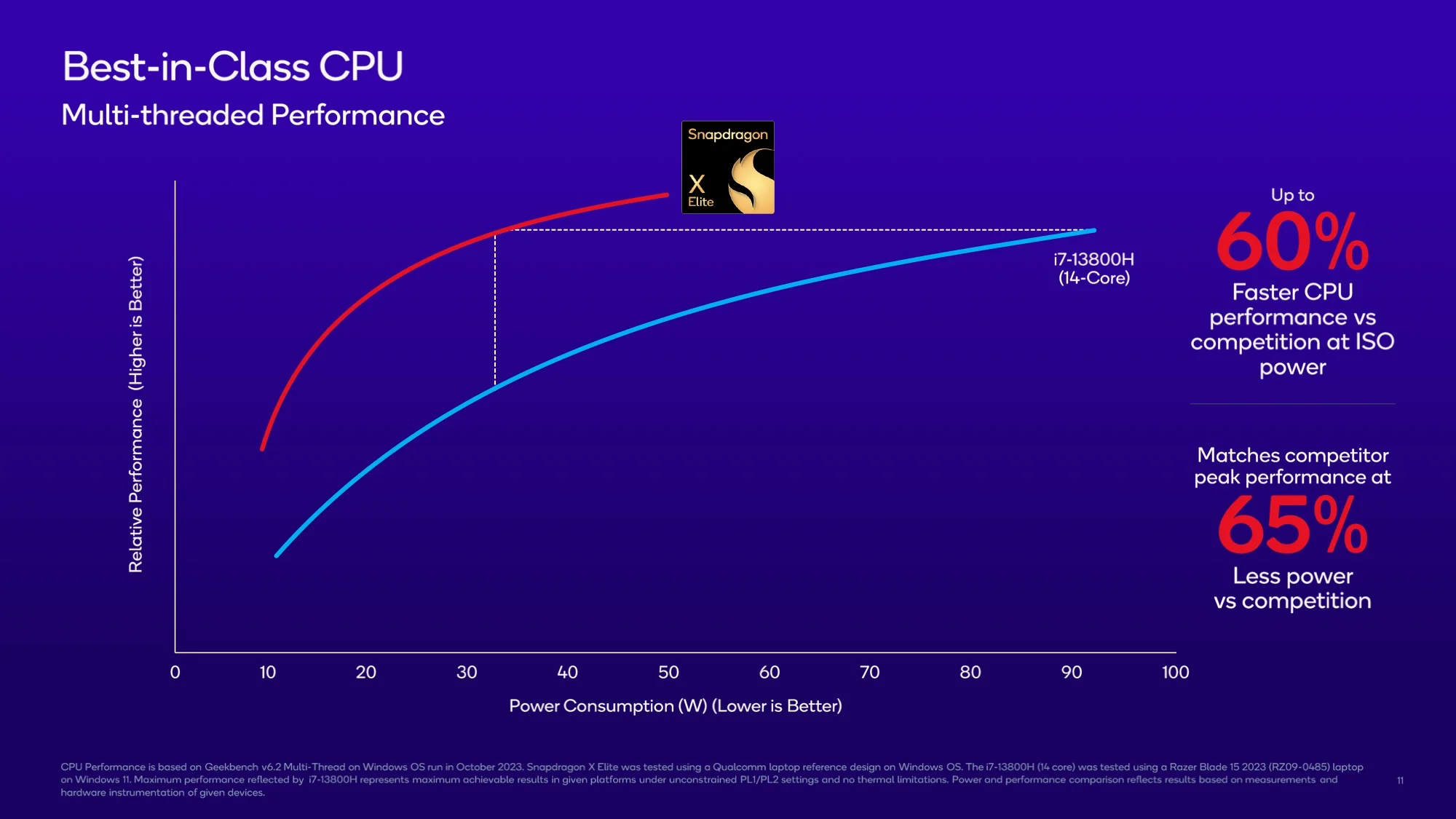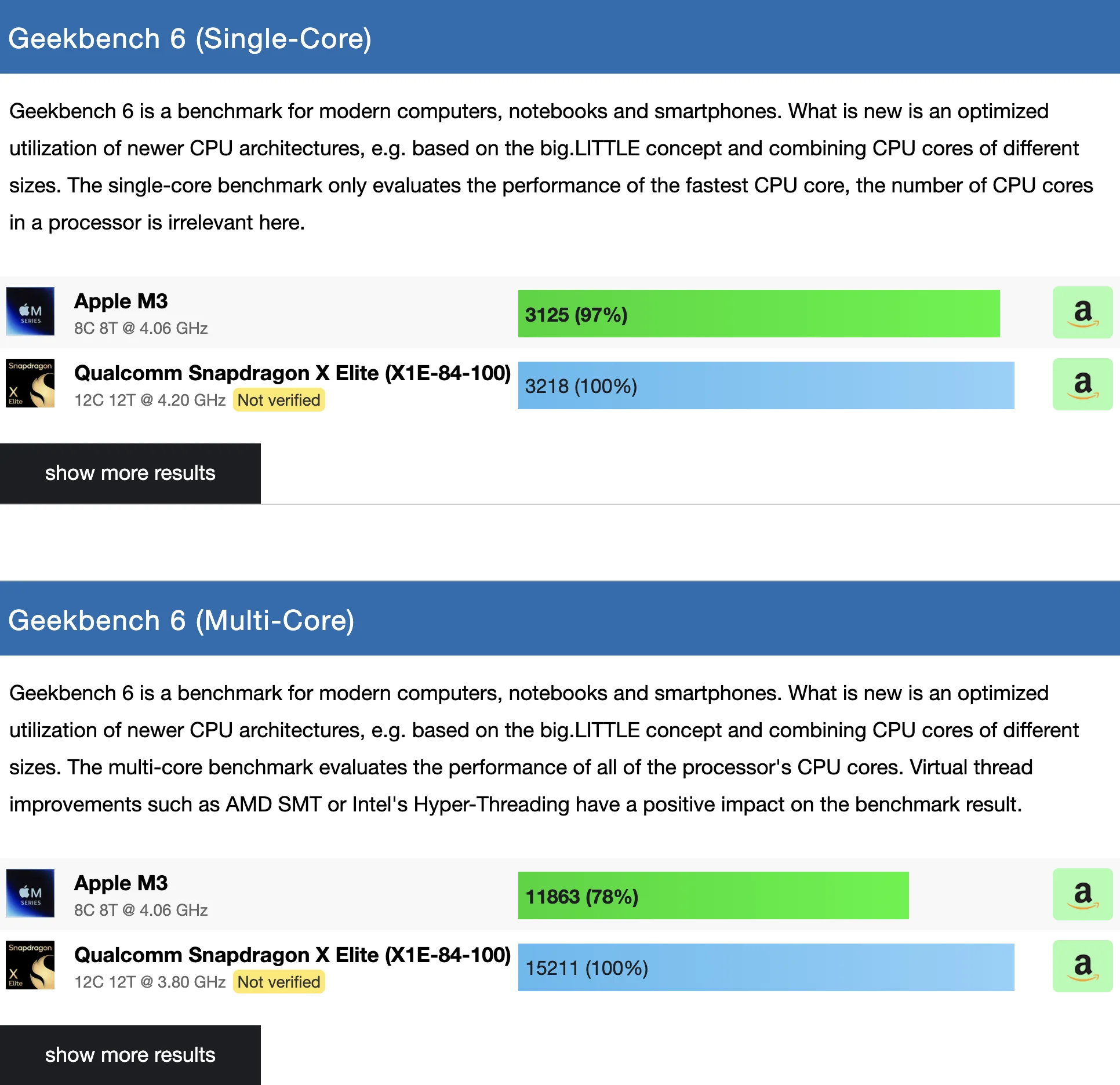In the land of ARM mobile chips that power laptops, the fruit company reigns supreme with Apple Silicon. Today, there’s a new player in town from a nemesis that usually plays in the mobile space: Qualcomm. Granted, Qualcomm has been previewing the SnapDragon X Elite since last year, but now, the chips (and the laptops) are finally coming to market and giving Apple some good old-fashioned competition. At least, the laptop/tablet market will be interesting again after watching Intel struggle against Apple. Can Qualcomm make a dent in Apple’s universe?
Details
SnapDragon X Elite was previewed back in October 2023 in a media event where Qualcomm claims to bring the power and efficiency of their mobile chip to the laptop. To match what the competitor is selling, they have to make a laptop run as fast as what is powering the Apple MacBook Air or Dell laptop and make it run for at least 20 hours. That is the minimum benchmark.
Qualcomm has a different management style than say Apple. Unlike Apple, Qualcomm is a chip merchant and sells components for manufacturers like ASUS, HP, Dell, and Microsoft. They would have basic designs for chips but can tailor-made ones if you have special needs.
Hence, the SnapDragon X Elite like their mobile counterpart SnapDragon 8 Gen 3 is made up of different chips (or cores) that are specialized to a certain function. Qualcomm then can add or subtract different kinds of cores to meet your specifications or design goals.

Just like the M4 from Apple, the SnapDragon X Elite has several different cores doing different things like graphics, signal processing, wireless connectivity, and plain-jane general computing.
For the general processing, Qualcomm designed new Oryon cores and in the case of SnapDragon X Elite, 10 cores are running general processing. Unlike their mobile counterpart, all 10 cores running on the SnapDragon X Elite are performance cores that share a big 42 MB cache.
For graphics, they turn into their trusty Adreno Cores which can push dual 5K60 displays at the same time.
The new industry parlance is the NPU or Neural Processing Unit where a specialized core or chip is used to do the AI processing heavy lifting. Qualcomm has been using the Hexagon cores for AI processing since 2006 and the one in SnapDragon X Elite is the latest one capable of doing 45 trillion operations per second.

Qualcomm also added a few specialized cores like the Adreno VPU to help decode H.265 videos, an X65 modem to handle Wi-Fi 7 and 5G signals, and an unnamed core to handle I/O. The SnapDragon X Elite has enough bandwidth to handle 3x USB4 channels. That’s around 120GB/second of theoretical bandwidth.
In addition to SnapDragon X Elite, Qualcomm also announced a “budget” version of SnapDragon X Plus with 2 out of the 10 cores disabled. Such practice is common in chip manufacturing to increase yield and help sell less-than-perfect chips.
The SnapDragon X Elite is built on the 4nm manufacturing process. Why didn’t Qualcomm use the latest 3nm manufacturing process? The reason is simple, Apple bought all the manufacturing lines so players like Intel and Qualcomm have to make do with “scraps”.

Performance
Measure performance is a bit tricky with the SnapDragon because this chip has been announced since last year but there’s no sample of it in the wild. So we have to take Qualcomm’s word for it and some “leaked” results.
If the leaked results are to be believed, SnapDragon Elite X performance should sit between Apple’s M3 and M4 mobile consumer chips. No bad for a first outing.







Conclusion
While the SnapDragon X Elite is competitive, there is more to it if you read between the lines. First off, the idea that a single chip does everything is officially dead. Just like the human brain, different kinds of cores come together on a single die to make something new. The whole indeed is greater than the sum of its parts. Second, and I think is more important, the new capabilities these multi-purpose chips brings to the table.

Microsoft has capitalized on the new chip by introducing new features that can only be enabled by Qualcomm SnapDragon X Elite because of the NPU features and efficiency. The most exciting times is when we found new capabilities and find new ways to use said capabilities.
Finally, some competition will do not only for Apple but us end-users alike. Qualcomm has pushed the needle, encouraging Apple to do the same.
Plug
Support this free website by visiting my Amazon affiliate links. Any purchase you make will give me a cut without any extra cost to you
| Base | Pro | |
|---|---|---|
| iPhones | iPhone 16 / iPhone 16 Plus - (Amazon) | iPhone 17 Pro / iPhone 17 Pro Max - (Amazon) |
| iPhone Accessories | Find them at Amazon | |
| Watch | Apple Watch SE (Amazon) / Apple Watch Series 11 | Apple Watch Ultra 3 (Amazon) |
| AirPods | AirPods 4 (Amazon) | AirPods Pro 3 (Amazon) / AirPods Max (Amazon) |
| iPad | iPad 10 (Amazon) / iPad Mini (Amazon) | iPad Air M3 (Amazon) / iPad Pro M5 (Amazon) |
| Laptops | MacBook Air M3 (Amazon) | MacBook Pro M5 (Amazon) / MacBook Pro M4 Pro/ M4 Max (Amazon) |
| Desktop | Mac Mini M4 / M4 Pro (Amazon) / iMac M4 (Amazon) | Mac Studio / Mac Pro |
| Displays | Studio Display (Amazon) | Pro Display XDR (Amazon) |
Other Ecosystem Items
